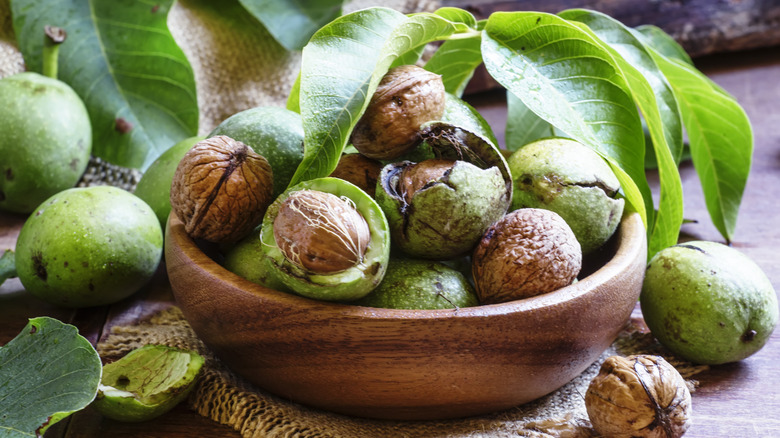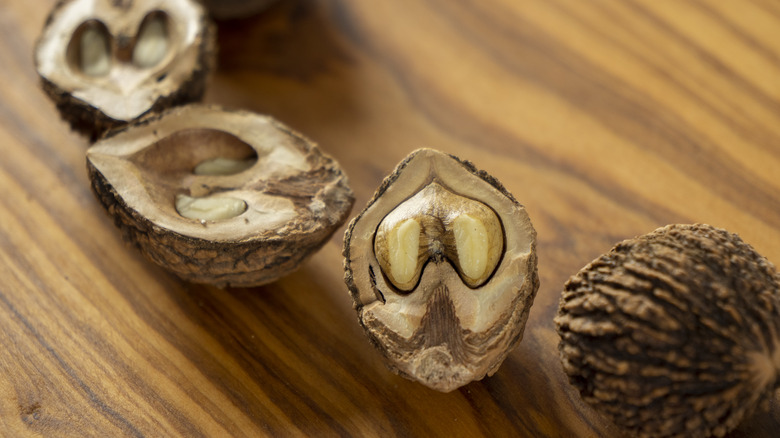The 2 Main Types Of Walnuts, Explained
Though China produces the most walnuts worldwide, the United States takes a solid second place, producing a hearty one-third of total global walnut production — that's not counting home growers and small-time walnut groves meant for personal or local consumption. Most of the walnuts we pop in our mouths, munch in our morning cereal, or chop into baked goods look very similar, so it's easy to assume that one primary species fuels America's prolific walnut yield. But it's not that simple.
In fact, two main types of walnuts flourish in the United States. The most common one, especially in commercial growth, is the English walnut, also known as the Persian walnut, because of its early cultivation in what is now modern-day Iran. The second type is the black walnut and its cohort, the California black walnut.
The walnut family tree has deep roots and widespread connections, with quite a few cultivars and variations in the English variety. And to dig even deeper, the black walnut serves as rootstock for English walnut cultivars, according to the Agricultural Marketing Resource Center. Here's a look at the dominant, beloved English walnut and its earthy, wild, relatively elusive counterpart, the black walnut.
English walnuts have lighter coloring and a mild flavor
Thanks to Spanish Franciscan missionaries reportedly hauling walnuts to California around 1770 and Joseph Sexton planting California's first commercial walnut orchard in 1867, the state reigns as the nearly exclusive commercial producer of America's walnuts, explains Iran Dried Fruit. And the vast majority of them are English walnuts.
English, or Persian, walnuts bear the scientific name of Juglans regia and contain mostly protein and fats, notes Healthline. They also harbor rich nutrients, antioxidants, and omega-3 fats, potentially protect the brain and heart, and maybe even ward off cancer.
This variety of walnut sports blonde-colored shells and similar, uniform hues for the inner nuts. The shells are relatively thin for easy cracking, and the nuts nurture a mild flavor that blends well in recipes for salads, desserts, bread, soups, and as roasted nuts with spicy or cinnamon seasoning. They also come in varying commercial cultivars, such as Tulare, Chandler, and Hartley, each with its own features.
As for the conflicting names, history sheds some light. Walnuts existed thousands of years ago, long before America was a gleam in the eyes of English and European settlers. Walnuts reportedly adorned the Hanging Gardens of Babylon somewhere around 2000 B.C., and records from Greek and Roman civilizations date even further back. As the hearty little nut traversed the globe, Persians cultivated the varietal we know today as English walnuts, so named for the English merchant ships transporting and trading them abroad.
Black walnuts have a darker exterior and deeper flavor
The black walnut, scientifically Juglans nigra and native to North America, is far less common than its English walnut counterpart. They carry similar health benefits, but the blacks contain higher amounts (via WebMD). In addition to notable levels of iron, fiber, and minerals, the concentrations of polyunsaturated fatty acids and antioxidants surpass those of English versions. They also provide more protein than any known tree nut.
It's easy to spot the wild-grown black walnuts by the distinctly black or streaky-black shells. After popping one in your mouth, you'll notice a deep, rich flavor that's bold on the palate compared to the lighter taste of English ones.
This walnut variety rarely grows commercially in America, though exceptions exist, particularly the nuts from Hammons Black Walnuts. The family-owned business in southwest Missouri has been selling black walnuts, which they call the "truffle of nuts," for at least 70 years. They source wild-grown nuts from gatherers throughout the Ozarks region and multiple U.S. states.
Hammons eschews automated picking machines and commercial production methods, instead hand-gathering the natural, 100% sustainable nuts and hulling them in more than 200 local hulling stations, per YouTube. Remarkably, the low-key operation provides consumers with about 25 million pounds of black walnuts every year. Because of the extra-thick shells on black walnuts, they easily contribute to sustainable practices, which include grinding or breaking them down for earth-friendly uses in water filtration, oil field media, and abrasive cleaning products.


